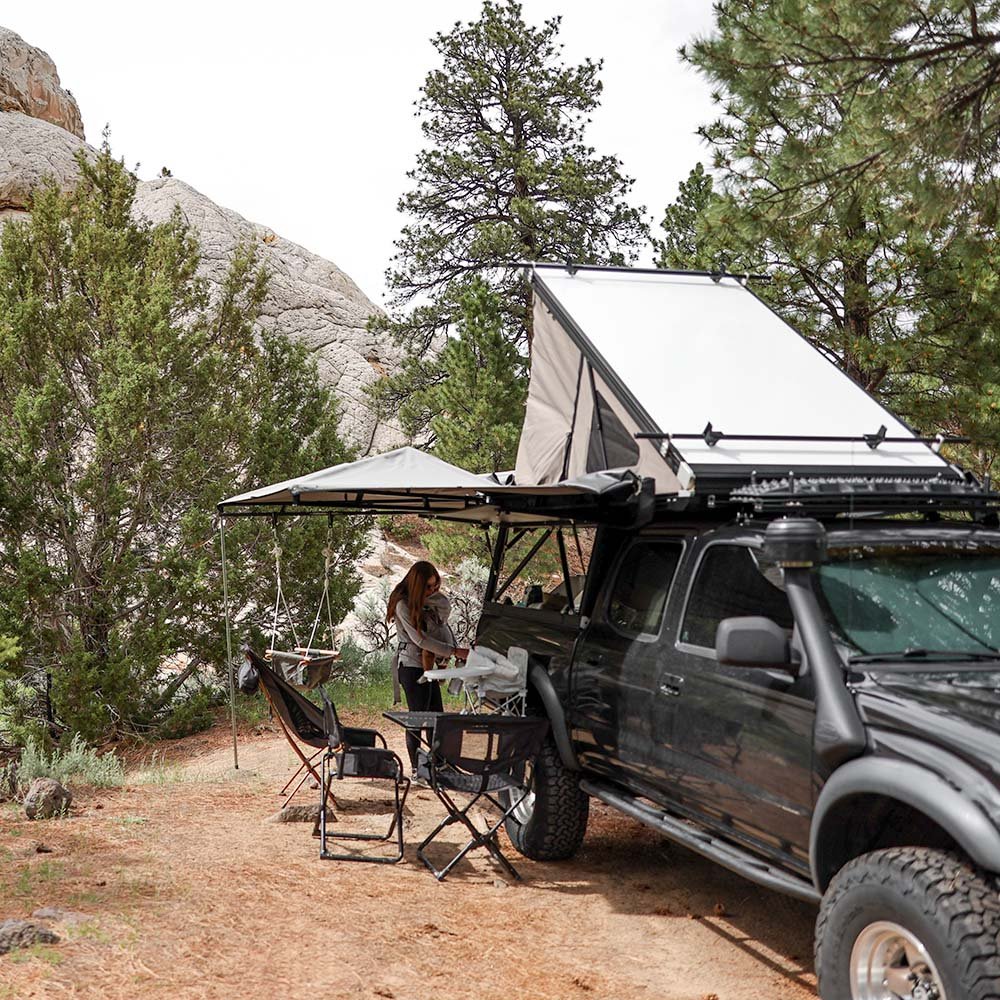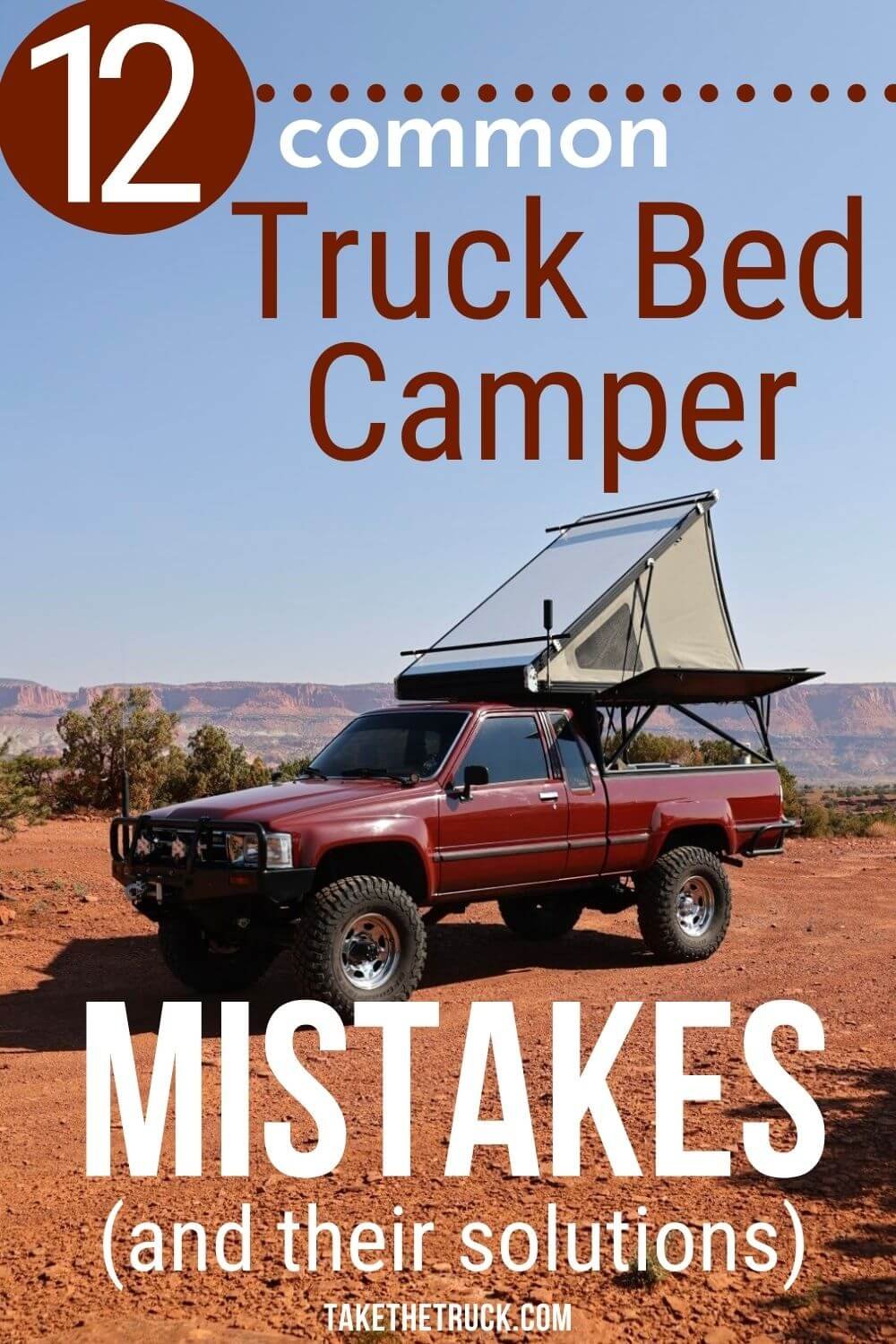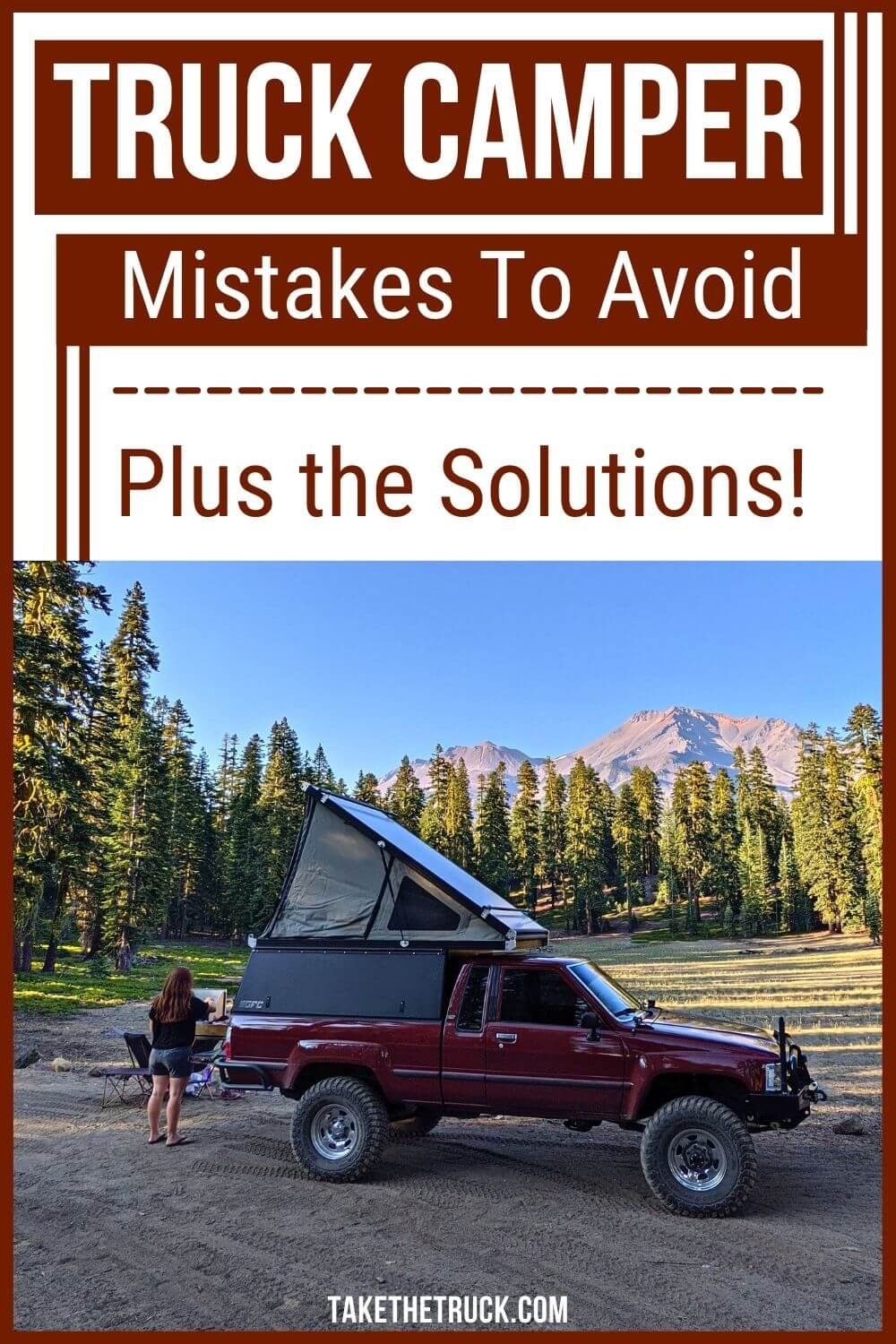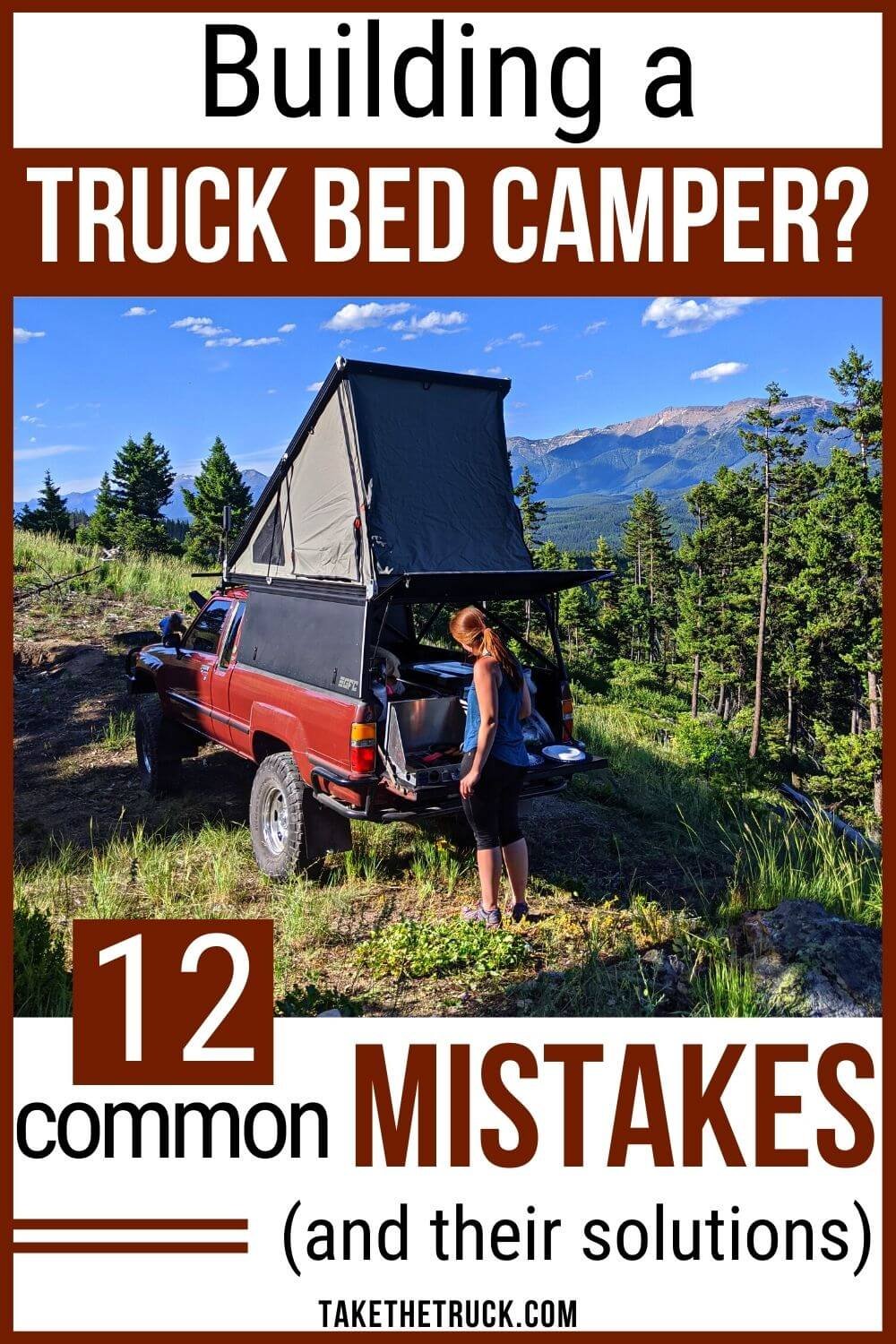12 Truck Bed Camper Mistakes and How to Avoid Them
We love truck bed campers, and think that truck camping is the absolute best way to camp, travel, and see the world. Since we began truck topper camping as a family years ago, we’ve logged over 100,000 miles of travel in our various truck bed camper setups.
Along the way we’ve learned a lot from our mistakes, so in this post we’re sharing the 12 most common mistakes new truck bed campers make when first starting out, and how to avoid them so you can begin your adventures in your truck bed camper a little easier than we did.
*(This post contains affiliate links. This means we may receive a small commission, at no additional cost to you, if you make a purchase through a link. See our full disclosure.)
Overthinking Your Truck Bed Camper Setup
There are seemingly a million truck bed camper and truck topper camping setups online, each with its own pros and cons, making it easy to get overwhelmed or to over-complicate your truck bed camper plans.
We put together two guides to help you narrow down your choices and ultimately choose a truck topper and truck bed camping setup that’s right for you.
In our guide How to Choose a Truck Canopy for Truck Topper Camping we cover in-depth the primary types of truck bed campers you can choose from.
And in our Guide to Sleeping Platforms for Truck Camping you can weigh the pros and cons of each of the main types of truck bed camper platform designs.
SOLUTION:
Start Simple
Once you have your truck topper or truck camper on your pickup, we recommend starting with one of the more basic truck bed camper setups, and taking a few weekend trips - find out what works for you, and what doesn’t.
Someone who plans to sporadically solo camp a weekend or two here and there will have drastically different truck bed camper needs than someone (like us) who plans to travel and camp for weeks at a time as a family.
Too Much Weight
With any truck topper camping setup weight is a crucial consideration, and there’s a delicate balancing act between having the truck camping gear you need, the truck bed camper you want, and your truck’s limitations.
Excessive weight will slow your truck down, tax your vehicle’s suspension and drivetrain, decrease fuel economy, and potentially be a safety risk if the weight of your truck bed camper and gear exceeds your truck’s Gross Vehicle Weight Rating (you can learn more about this here).
SOLUTIONS:
There are four ways to manage weight in a truck bed camper.
Keep the Weight of Your Truck Bed Camper Setup as Low as Possible
When selecting a truck bed camper and building any sleeping platform there are a trade-offs to consider that will affect the weight of your overall truck bed camper setup. While these are discussed in greater depth in the links in the section above, these are the three main things to consider:
Truck Bed Camper Materials - whether your truck bed camper is built with plywood, fiberglass, aluminum, or composite materials will impact the total weight
Complexity - items like long drawer slides, a 12v camping fridge, your truck bed camper’s power or solar setup (discussed more below), etc all come at a cost of additional weight. The more amenities you add the greater the weight
Size - the larger your truck bed camper, the more weight your truck must be able to safely accommodate
Pack Less Stuff in Your Truck Bed Camper
This is pretty straightforward; once you get a few truck camping sessions under your belt, take an inventory of all your gear and remove anything you never used (excluding safety/recovery gear, which we’ll discuss further below). Also check if you packed an excessive amount of food, or water and adjust that next time you go out.
By regularly repeating this process, you’ll eventually streamline your truck camping gear and reduce weight.
If you’re planning on traveling in a truck bed camper for any length of time, keep in mind that access to water and food is readily available in most places as you travel. As an example, on a typical 4-6 week truck bed camper trip we typically carry about 5-7 days of food and only about 10 gallons of water (as well as a high quality water filter* for emergency use) at any given time for our family of three, and we simply stop and restock along the way.
Use Light Weight Truck Camping Gear and Accessories
Another way to reduce weight is to utilize ultralight camping equipment. Much of the gear designed for use in backpacking is also perfect for truck topper camping - it’s light-weight, compact, and because it’s typically very durable (having been designed for the abuse and rigors of the trail). Though this gear will usually cost more than bulkier camping equipment, we’ve found it to be worth the investment.
Invest in a Suspension Upgrade for Your Truck Bed Camper
While a suspension upgrade to your truck won’t resolve your weight issues, it will improve your truck’s ability to handle the weight of your truck bed camper while reducing the likelihood of excessive wear on mechanical components.
Limited Interior Space
Every truck bed camper has a finite amount of interior space, so to fully enjoy your truck camping experience you’ll want to utilize both the interior and exterior space as efficiently as possible.
SOLUTIONS:
Use Compact Gear
As we discussed above, using things like collapsible backpacking chairs, tables, etc. are a great way to save space.
Leverage Exterior Storage Options to Maximize Space in Your Truck Bed Camper
Adding a roof rack or hitch-mounted cargo basket can allow you to store bulkier items like coolers, water tanks and showers, camp chairs, firewood, or even a 12v camping fridge (like we did) on the outside of your truck bed camper, freeing up valuable interior space.
Install a Truck Camper Awning or Carry a Tarp
A truck camper awning, overland awning, or tarp can provide protected spaces to relax or to cook under in inclement weather, and shade from the heat when camping in direct sunlight.
Consider investing in a Wedge Camper or Pop-Up Truck Bed Camper
These can provide a massive increase in your truck bed camper interior space and head room while maintaining a similarly low-profile to a traditional truck topper, canopy, or camper shell. We ultimately invested in a Go Fast Camper to increase the interior space for our truck bed camper setup and it’s been an absolute gamechanger! And there are a ton of great lightweight small truck campers to choose from - check out our post on The 25 Best Lightweight Small Truck Campers
Being Disorganized
Without a system for keeping your truck bed camper organized, your already limited interior space will quickly become a claustrophobic mess. So finding some ways to keep your truck bed camper organized will go a long way in improving your overall truck camping experience.
SOLUTIONS:
Getting Your Truck Bed Camper Organized
There are a ton of ways to get your truck bed camper back in shape and well organized, here are two helpful guides that can get you started:
Truck Bed Camper Interior: Organization and Space-Saving Storage Ideas
Stress-Free Camping Storage Ideas for Organizing Your Camping Gear
Using Built-In Storage in Your Truck Bed Camper
Also consider including a long slide-out drawer into your sleeping platform build for storing your camp kitchen gear - this will be some of the most frequently accessed gear in your truck bed camper, so making it as simple as possible to get to and pack up will make your life WAY easier.
At the very least, organize this gear into one place - here’s How to Set Up A Portable Camping Kitchen Box.
Weather Sealing and Dust Proofing
An improperly sealed truck bed camper can allow water and dust into your truck topper. And nothing can ruin a truck topper camping experience faster than having your gear, clothing, or food soaked or coated in dust.
While it’s nearly impossible to completely seal a truck bed camper (nor should you - we’ll discuss ventilation more below), there are a number of ways to help keep the elements out.
SOLUTIONS:
Weather Sealing Your Truck Bed Camper
Install a high quality truck bed camper seal, like this one from ESI* that we used. This seals the contact surface between your truck bed and truck topper.
Leaking windows in a truck bed camper is another common weather sealing issue. So if you’re installing a used truck bed camper, be sure to pull and reseal your truck canopy’s windows with fresh butyl tape*.
If you’re not comfortable doing these things yourself, consider having a professional properly install your truck topper and ensure any windows are adequately weather sealed - it’ll be well worth the investment in the long run.
Dust Proofing Your Truck Bed Camper
One area that commonly allows dust into your truck bed camper is through the tailgate. You can help limit this by installing a good tailgate seal* in any unsealed areas around your truck’s tailgate.
Creating positive pressure in your truck bed camper is another great way to keep dust out. There are two ways to do this:
Install a simple pop-up positive pressure vent* - when installed in the roof of your truck bed camper, this will force air into the truck topper as you drive.
Install a two-directional Vent Fan, like the Maxxfan Deluxe Vent Fan we used* (more on this below), in your truck bed camper - in the proper high setting the vent fan can force enough air into the truck canopy to create positive pressure and keep dust out.
Inadequate Ventilation
If your truck bed camper isn’t ventilated you’re going to be both uncomfortable in hot weather and constantly fighting condensation issues (especially when cold weather camping). Either scenario can lead to a miserable truck topper camping experience.
SOLUTIONS:
Open Some Windows
If your truck camper has two windows, opening them to allow some cross-ventilation can help limit condensation and/or heat build up. This, along with installing a carpeted liner in your truck bed camper, will help ensure a more comfortable truck topper camping trip (even when cold weather camping).
Install a Vent Fan in Your Truck Bed Camper
This is the BEST way to ventilate your truck bed camper, limit condensation and heat build up, and stay comfortable while summer camping in hot weather. Check out out step-by-step guide for details:
Inadequate or Uncomfortable Sleeping Gear
It’s hard to put a price on a good night’s sleep. Using inadequate sleeping gear in your truck bed camper is an easy mistake to make that can absolutely ruin your sleep while truck topper camping.
SOLUTIONS:
Get a High-Quality Truck Bed Mattress
Selecting the right truck bed mattress for your truck camper is step one, and we have an entire post dedicated to Choosing the Best SUV or Truck Bed Mattress to help you find one that’s right for you.
Choose a Quality Sleeping Bag for Your Truck Bed Camper
A high-quality sleeping bag can make a huge difference in your truck bed camper sleeping setup. There are two main factors to consider when looking for a sleeping bag for your truck bed camper
1. Down vs Synthetic Fill
Down-filled sleeping bags are more compressible and down has a higher insulating value than synthetics, but it will lose it’s insulating ability if it gets wet. If you go with a down bag for your truck bed camper, make sure it uses hydrophobic down - like the Thermarest Vela 20* we currently use - so that it’s not as impacted by condensation or moisture.
Synthetic-filled sleeping bags are great for most truck bed campers because they retain their insulating properties when wet, though they are more bulky to store than down. We used the Big Agnes Dream Island 15* for years in our truck bed camper and loved it!
2. Temperature Rating
Most manufacturers state their sleeping bag temp ratings in a couple ways. There's the “survival temp” - meaning technically you will survive if temperatures dip that low, and there’s the “comfort temp” which is the temperature at which you’ll actually sleep comfortably.
Be sure to select a sleeping bag for your truck bed camper that has a comfort rating that meets your needs for the climate you’ll be camping in.
Insufficient Camping Power Setup
If you’re a road warrior, planning to work remotely from your truck bed camper, or hoping to include things like a 12v camping fridge or vent fan in your truck topper camping setup, you need to make sure your truck bed camper power setup is up to the task.
SOLUTION:
Calculate Your Camping Power Needs and Select a Camping Power Supply That Meets Them
Unfortunately, everyone’s power needs are different depending on the type of truck topper camping they do - so we’ve put together this complete three part series of posts that will help you figure out a truck bed camper power solution that meets your needs and budget.
Electrical Terms and Principles Made Simple
If you’re unfamiliar with truck bed camper 12v systems, this guide will cover the basics and help you understand truck topper camping electrical principles.
Determine Your Power Supply Needs
This guide will teach you how to assess your power needs while truck topper camping and determine how much power storage you need in your truck bed camper.
Selecting a Camping Power Supply
Once you know your actual power needs, this guide will help you make an informed decision on what truck bed camper power supply is right for you.
Truck Bed Camper Security Issues
The majority of truck bed camper security concerns revolve around two main issues: theft and confrontation with others.
SOLUTIONS:
We have an entire guide on Wild Camping Safety & Security that goes into greater detail on this topic, but here are some of the truck topper camping specific security tips:
Truck Bed Camper Theft Prevention:
Most instances of theft are crimes of opportunity - simple smash and grab jobs where someone sees something they want of value in plain sight, so they break a window in your truck bed camper or simply walk off with it.
Install dark window tint on your truck bed camper’s windows and/or install truck bed camper curtains to keep your gear and valuables out of sight.
Carry your valuables with you - this is an obvious one but worth mentioning. Things like your wallet, keys, jewelry, important documents, etc are generally small and easy to carry when you leave your truck bed camper.
Be friendly with your camp neighbors (if you have any). That’ll make them more likely to notice if strangers are hanging around your truck camper when you’re not around.
Tuck any loose camping gear away when leaving your truck bed camper - if it’s out-of-sight, it won’t tempt anyone. And secure anything that can’t be put away with a cable lock*.
Consider leaving music playing in your truck camper when leaving for a hike.
Bring a dog, or have a ‘dog inside’ sticker on your truck bed camper if fitting.
Carry a diversion safe for valuables you need to leave inside - for example: you can keep one of these faux soda cans* in your truck bed camper’s 12v fridge or cooler.
We’re also big fans of Apple AirTags* for keeping tabs on valuables in the event they get misplaced at camp (or stolen)
Dealing with Human Confrontation while Truck Camping:
Generally this is not something you’re going to run into when camped remotely in your truck bed camper. In over a decade of traveling and camping we’ve never had a human interaction where we felt our safety was at risk. However, there are some simple safety measures you can take to provide some piece of mind.
We have a complete Guide to Emergency Communication Devices covering a variety of ways to stay in contact while truck camping. Our go-to recommendation is a simple Garmin In-Reach Mini* to offer peace of mind in the event help or emergency services are needed in areas without cell service.
If camping solo, leave a second chair and a pair of extra boots outside to make it appear you’re camping as a couple.
If your truck has a remote alarm, sleep with your keys nearby in your truck bed camper to activate the alarm if needed. Alternatively, keep a small air horn* to both startle would-be intruders and alert others if needed.
Carry bear spray and know how to safely use it - this is a great (somewhat) non-lethal form of self-defense to carry with you that works on both animals and humans.
Keep a super bright self-defense flashlight* on hand, plus the strobe feature is great for signaling if needed.
Trust your gut, and don’t completely set up camp if you’re feeling uneasy with a site (leave the awning in, camp chairs packed, etc) so you can drive away quickly and easily if needed. Better yet, simply leave and find a different place to camp if one is available.
Poor Campsite Selection and Setup
One of the best parts of camping in a truck bed camper is the ability to get to more remote, and often free, dispersed campsites. But poor campsite selection, truck bed camper positioning, and improper setup can be a major mistake while truck camping.
SOLUTIONS:
Finding Awesome Free Camp Sites
We have a detailed guide on How to Find Free Camping Like a Pro that will help you find awesome free campsites to take your truck bed camper.
Selecting a Site for Your Truck Bed Camper
Be aware of flood zones - don’t travel through them during heavy rain and never set up camp in them. The average vehicle can be displaced by only 2ft (or less) of flowing water.
Know the area fire danger levels and restrictions so nothing gets out of control, as well as any fire weather advisories.
Speak with a local ranger or game officer and make yourself aware of local hunting seasons before selecting a site. If you do select a site in areas where hunting is permitted, wear brightly colored orange vests and hats at all times while camping.
Truck Bed Camper Positioning & Leveling
Try to arrive at remote campsites during daylight so you can see any potential hazards or obstacles when parking your truck camper.
Always check for “widow maker” limbs or leaning dead trees that could pose safety hazards before parking your truck bed camper.
Shade can make a significant difference when summer camping. If you’re unable to park your truck camper in the shade, try facing the nose of your truck west to minimize the amount of direct sunlight on your truck topper or canopy.
Properly leveling your truck bed camper will make sleeping more comfortable and cooking a lot easier (no sliding pots and pans on the camp stove). Carrying a simple 360 degree bubble level* and a set of leveling blocks* will help ensure your truck bed camper can be level in even severely sloped campsites.
Not Being Prepared for Off Road Driving
Without a doubt, one of the best advantages of a truck bed camper is that with only the footprint of a truck you have easier access to incredible places to camp. But to take advantage of these beautiful remote campsites you need to be prepared for the challenge. By selecting quality off-road tires for your truck, and carrying a basic set of off-road recovery gear (and knowing how to use it) you can help ensure you’ll be ready for the adventure.
SOLUTIONS:
Truck Bed Camper Tires
We have an entire guide that will help you select the best off road tires for your truck - just ensure that the tire you choose has a load-rating that is adequate for the weight of your specific truck bed camper setup.
Carry Basic Off Road Recovery Gear in Your Truck Bed Camper
An Emergency Communication Device - such as a GMRS radio*, HAM radio (license required), or Satellite Communicator to reach out for help when needed.
A Bottle Jack - these have a number of uses for truck bed campers, including changing or repairing tires and some moderate off-road vehicle repositioning. For more advanced options, check out our Complete Guide to Off Road Jacks
A Basic Vehicle Recovery Kit* - for vehicle assisted off-road recoveries. These kits include a snatch strap, shackles, and a pair of gloves.
A Set of Recovery Boards* - to provide traction in soft terrain conditions such as sand or mud
A Shovel* - to dig out your truck bed camper if it becomes mired or to make room for a jack or recovery boards.
A Saw* and/or Axe - to clear downed trees (and chop firewood too!)
A Portable Air Compressor* - for airing up tires after repair or airing down tires for better traction.
A Quality Tire Repair Kit* - for fixing flat tires
A First Aid Kit* - preferably with an accompanying wilderness medicine handbook for reference and an additional tourniquet*.
Learn How to Use Your Truck Bed Camper Recovery Gear
You can check out our detailed Guide to Off Road Recovery Gear that will teach you the basics of selecting and using this equipment while truck topper camping, and even if you’re not into “overlanding” - attending some of the Overlanding Expos or Overland Events that offer training courses will help you feel more confident in taking your truck bed camper off roading.
Mindset [Is a Truck Bed Camper Right for You]
While truck bed campers are an excellent way to camp and enjoy the outdoors, they aren’t right for everyone.
Even the largest truck campers can begin to feel cramped, especially in inclement weather. They can be more challenging for those with mobility issues to get in and out of. There can also be a learning curve with How to Bathe and How to Use the Bathroom in a truck bed camper. And with most truck bed campers, you’ll be forced to cook your meals outdoors. There are solutions to most, if not all, of these issues, but it can require a mindset shift.
SOLUTION:
Remember What Your Goal Is
The goal with any truck bed camper is to get you out there enjoying the outdoors! While there are some sacrifices, truck bed campers offer one of the best means of exploring while keeping your adventures comfortable (enough) and focused on the outdoors. It’s for this reason we recommend anyone considering a truck bed camper to start with something basic, try it out for a bit, and see if it’s right for you.
And you can check out 15 Reasons Truck Campers Are Better Than RVs to see why we personally decided that a truck bed camper was right for us.
There you have it - the 12 most common truck bed camper mistakes and how you can avoid them!
If you’re interested in more of our camping, overlanding, and family travel tips and guides, be sure to SUBSCRIBE. And if you have any questions about truck bed campers, please drop a comment down below.
As always, thanks for reading!
Related Posts:
Pin this Post!
We’d appreciate a share!





